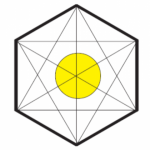I want to remark on something in Tomberg’s Meditations, in comparison between Chapter 18 (The Moon) & Chapter 19 (The Sun). Besides many other side meditations of delight (including a short, extremely well put defense of medieval scholasticism, which he says was a marriage of wisdom and intelligence to produce intuition), Tomberg gives us two symbols in each chapter. They are both based on the hexagram. Readers who frequent Gornahoor may recall that Mouravieff mentions the hexagram in connection with spiritual initiation, in his marvelous Gnosis. The hexagram (according to Tomberg) can be arranged either with two squatty triangles at the top and a rectangle in the middle (in which case it symbolizes antinomies and opposing lines which “eclipse” the Divine Intelligence in man and drive him back into the stagnant water which the crawfish or lobster is dwelling in on the card, The Moon), or it can form an interpenetrating two triangles, like the star of David, which is the Divine Trinity coming down, and the Earthly Trinity (of Mother Sophia, Daughter, & World-Soul) rising up. This last is the next card, The Sun.
This is a fabulous symbol which shows that the same facts, arranged in different configurations, produce entirely different results : it is simply a question of force-lines and spiritual energy, which makes the difference and either bars man’s path (The Guardian of the Threshold) or opens the gates of initiation. It is also worth noting that Evola speaks of something similar in his work on magic, related to ascending the different “steps”, each of which are guardians. Is there a particular “step” into the spiritual world which involves a hexagram and an all-seeing eye, which is either malevolent/protective or benevolent/benedictory?
If we accept the revelatory power of Tomberg’s symbolism, there is more food for thought here, beyond even private initiation or struggle. The Western path is asserted by Tomberg to be superior even to Eastern methods, not because they are superior when compared each to each on a level, but because the Western method was slightly more complete. Tomberg associates this with the woman in Revelations, whose footstool was the moon, clothes were the sun, and was crowned with stars.
Here, again, the moon & sun are juxtaposed, but the stars are additive. What are they? Tomberg claims that they are the Western edifice which goes beyond the Eastern transcendental Self which knows itself as God. Tomberg believes that (immortal and immutable, eternal and transcendent as it is) the Self actually can go “beyond” even itself, and meet other “Gods” – other selves which are the world of the hierarchies, angels, and other “just men made perfect”. These are “the stars”.
Immediately, we are transported to Dante’s emergence out of Purgatory:
“To get back up to the shining world from there
My guide and I went into that hidden tunnel,
And Following its path, we took no care
To rest, but climbed: he first, then I-so far,
through a round aperture I saw appear
Some of the beautiful things that Heaven bears,
Where we came forth, and once more saw the stars.”
Canto XXXIV
The medieval world was not oblivious to “Eastern doctrine”, but approached it from the Sankya-side, in refusing to ultimately identify the Self as the final pinnacle. Rather, the “Self” could begin a new ascent, and rather than find itself “frozen” or “alone”, looked up to see the other stars. The individual “purusha” or “monad” was affirmed, but a universal Purusha was not denied. As Tomberg remarks (and as a medieval man would readily agree) “for the devil, also, is transcendental and immortal”. V. Tomberg points to Jung as a thinker in the West who narrowly missed the Eastern way, and left a door for identifying a bigger horizon beyond even the archetypal Self. The spiritual moon is the Sun which shines at midnight, which (of course) in a manner of speaking is “just like the stars”, or points to the stars, which are smaller suns, shining at midnight.
It is this world which Tomberg writes to defend, as his Meditations defend the reality of the Tarot deck as a hermetic vehicle from the Middle Ages, meant to communicate what certain men of the West had learned concerning “the secret things of God”.

Thank you Logres for the kind words. I was not consciously hearkening to MoTT when writing this, but spent about 5 years around this time intensively studying the book so it’s not surprising if there’s some resonance!
That is (if I take your meaning) almost precisely what Tomberg was getting at, phrased symbolically and cosmologically? A stargate as a “guardian”? Beautiful poetry, regardless…
Squaring the circle!
Yes, a very important symbol, I actually used this at the start of my epic poem, The Myth:
http://alchemical-weddings.com/alchemical-weddings/hidden-stargates
and described it at the end of the introduction here:
There in orbit turn the star-lings,
Planets binding, suns inclining,
In such ways that whole dimensions
Fold inside the vaults of Heaven.
Angels watch the hidden stargates –
One from North, a second South-side –
East and West. The seal is six-faced.
Secret form – a cube, shaped inside.